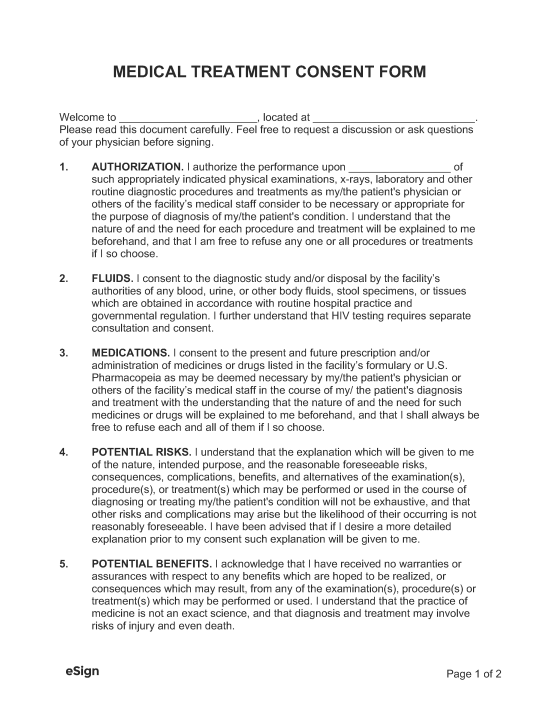Medical Consent Form for Minor – This form authorizes someone other than the parent or guardian to consent to medical treatment for a minor.
– This form authorizes someone other than the parent or guardian to consent to medical treatment for a minor.
Download: PDF, MS Word, OpenDocument
Informed Consent vs. General Consent
Practitioners use a general consent form to obtain consent for basic, routine care and testing.
Informed consent is required for intrusive and dangerous procedures such as surgery, high-risk medications, or certain vaccines. In these cases, the patient usually needs to sign additional consent forms, ensuring they have been given proper explanations about the risks, possible alternatives, and information regarding the procedure.
Four conditions are generally required for a patient to provide informed consent:
- Capacity. The patient must be able to understand what they are agreeing to. If they do not have the capacity, a healthcare surrogate may need to be appointed to make decisions in their stead. In some cases, an interpreter or translator may be required to assist the patient in understanding.
- Information Disclosure. The patient or decision-maker must be provided with enough information to make an informed choice and have the opportunity to ask questions.
- Understanding. The healthcare provider determines if the individual making the judgment has understood the information provided to them.
- Authorization. The patient or decision-maker consents to the treatment described by signing the document.
Important Elements to Include
A general medical consent form provided during the registration process at a healthcare facility will generally have the following elements:
Routine Procedures
The document will note that the patient consents to routine and non-invasive diagnostic and medical procedures. The form will also make it clear that the patient will be explained why each is necessary and that they can refuse any procedure or treatment they choose. These may include:
- X-Rays
- Use of local anesthesia
- Physical examination
- Blood drawing
Study and Disposal of Specimens
The form will state that the patient consents to the study and disposal of their bodily fluids, specimens, and tissues.
Medications
When signed, the patient agrees to be prescribed or given medicine that the healthcare provider deems necessary for their treatment. The patient will be explained what they are being given beforehand and may always refuse in the moment.
Assurances
The patient acknowledges that there are no guarantees regarding the outcome of any examinations, procedures, or treatments. The form relays that there is always a risk that the intended outcome may not occur and that a risk of personal injury or death may be involved.
Acknowledgment
If they choose to sign the document, the patient acknowledges that they have read and agree to the terms in the document and that they consent to treatment.

